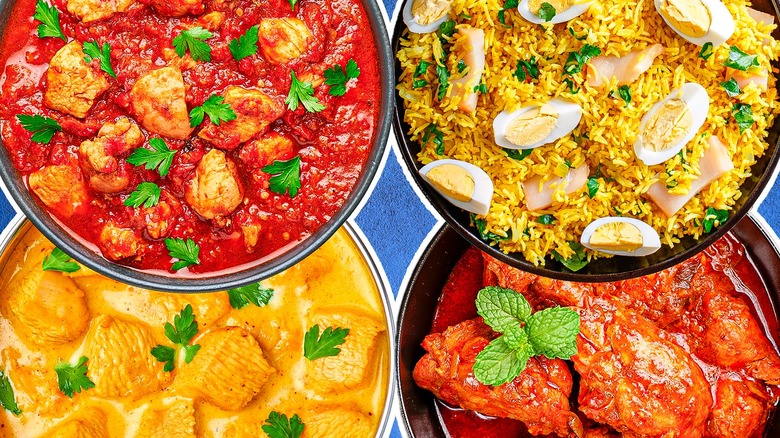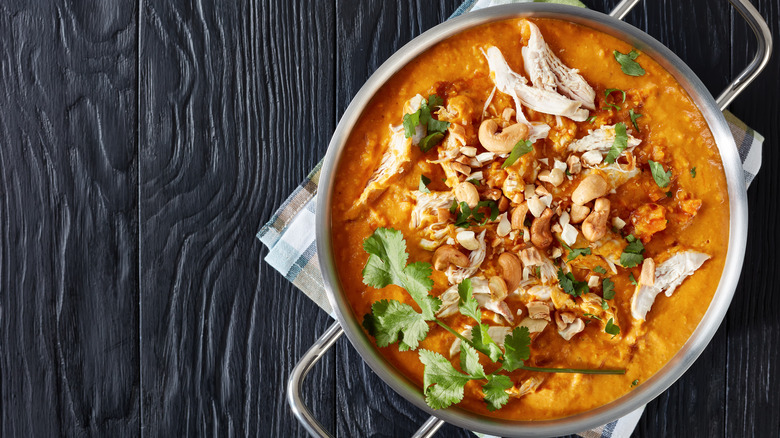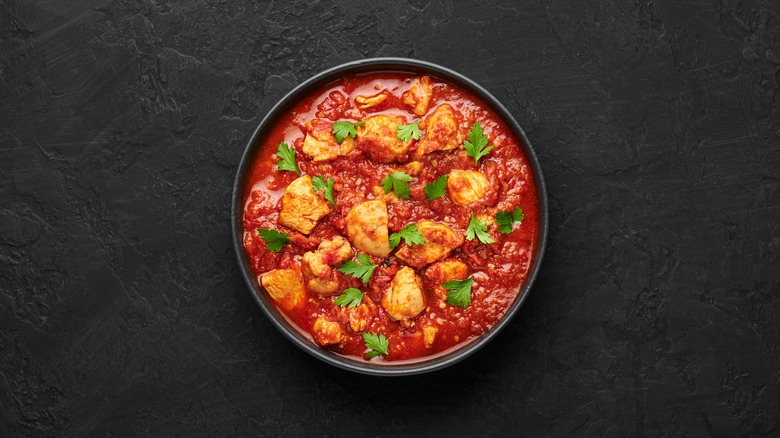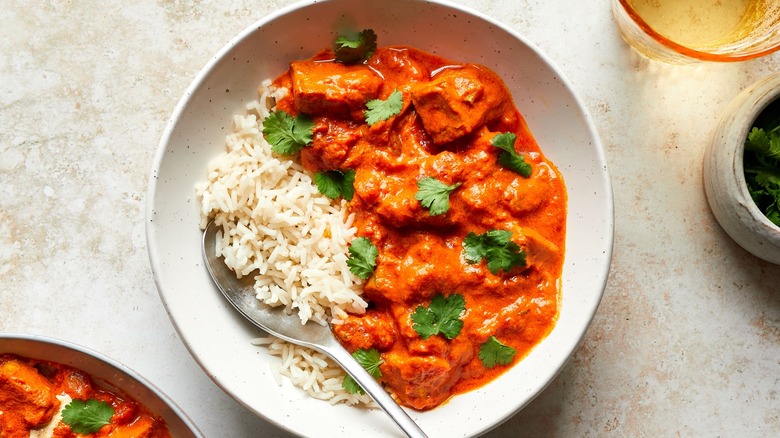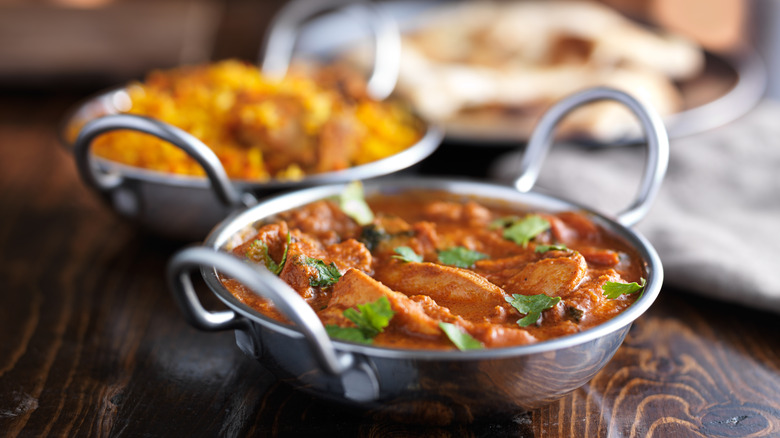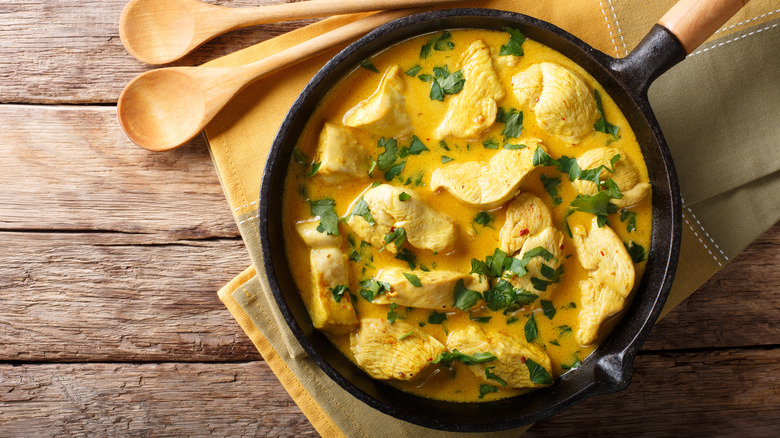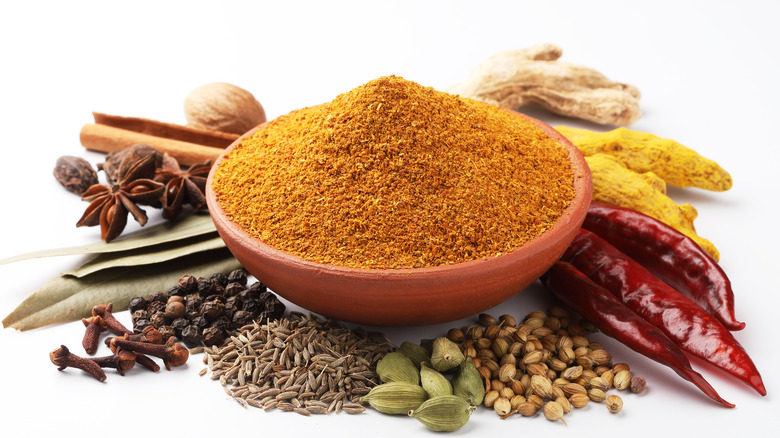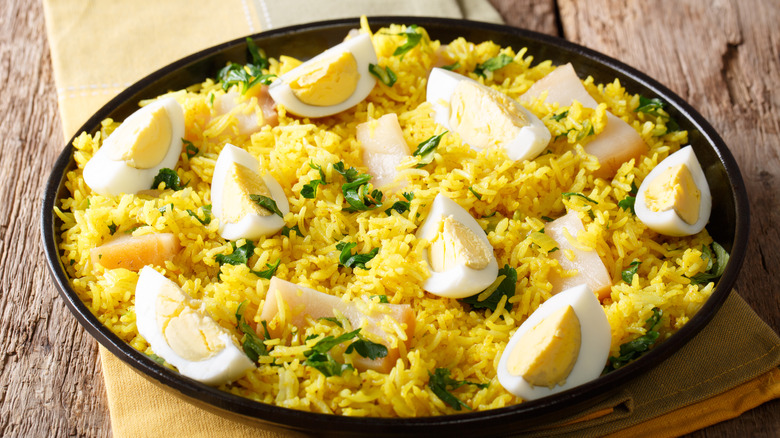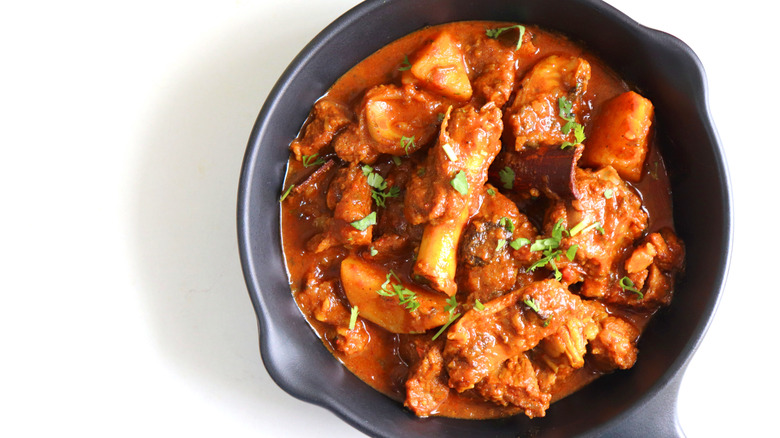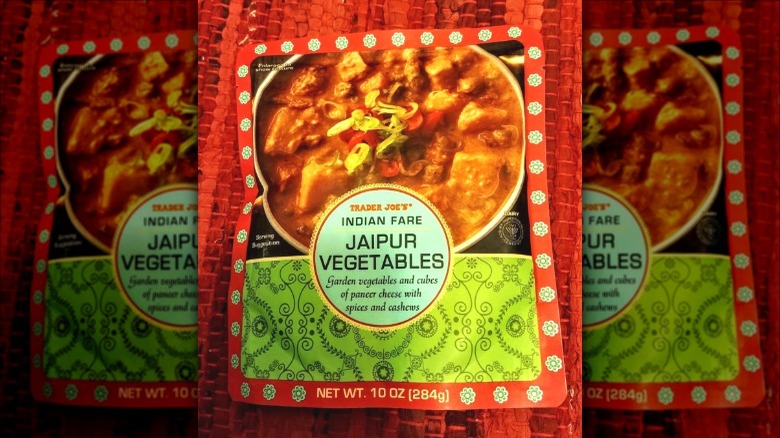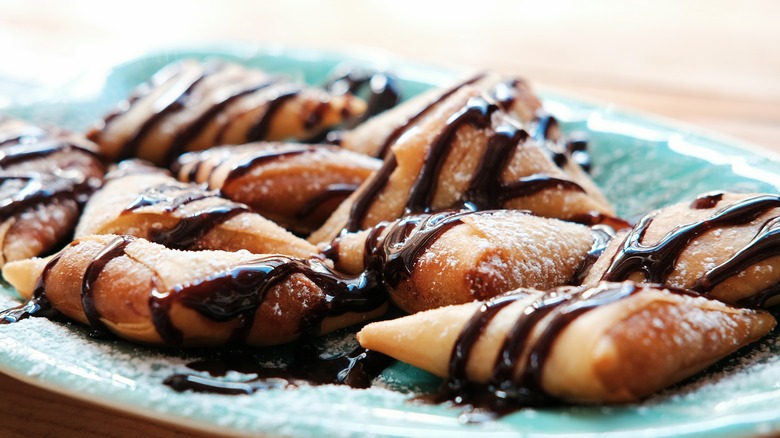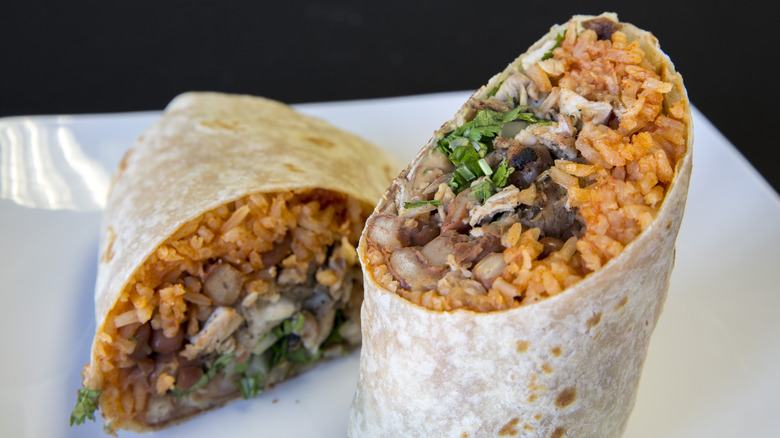Indian Dishes You Won't Find In India
Indian food is one of the most popular national cuisines in the world, and for good reason. In a nation with the second-largest population in the world and geography that includes Earth's highest mountain range along with sandy beaches, scorching deserts, and verdant rainforests, it's no wonder the culinary traditions are so wide-ranging and abundant. There's even a scientific reason Indian food is so popular. Researchers at the Indian Institute for Technology discovered that, unlike many other types of cuisine, which tend to combine similar flavor compounds within each dish, Indian food often mixes vastly different flavors into individual recipes. This is largely due to the number of spices present in many dishes which offers a complex and unique flavor profile that people find irresistible.
Indian food is so ubiquitous that many of the menu items have as much name recognition as spaghetti bolognese or sushi. But while you may think you're taking a virtual journey to India with every bite of curry or painful nibble of fiery vindaloo, you might not be enjoying a dish from India at all. Many dishes that populate Indian restaurant menus are inventions that sprang up in other countries or were so heavily adapted from the original that they are unrecognizable to their country of origin. In some cases, they were created by the Indian diaspora living in the U.K. and have been proudly adopted by the British. From korma to chocolate samosas, keep reading to discover the so-called Indian dishes that you won't find in India.
Mulligatawny soup
Mulligatawny is a flavorful, creamy soup typically made with meat, vegetables, and Indian spices. It's a warming, aromatic dish with a hint of sweetness and a healthy dose of vegetables that is perfect comfort food for a rainy day. But while the fragrant spice combination might be reminiscent of Indian cuisine, you probably won't find the soup at many restaurants in India. Mulligatawny emerged during the British Raj in the mid-19th century when the colonialists insisted that their Indian cooks provide them with soup. Over time, the cooks tinkered with a traditional light, fiery Madrassi broth made with peppers, water, and tamarind known as molo tunny (meaning "pepper water") to create a richer, more substantial dish that the British would enjoy, and mulligatawny was born.
Chutney or apples are often added for sweetness, with cumin, ginger, coriander, and various vegetables rounding out the flavor. It's a delicious, nourishing soup, but you're unlikely to find it on restaurant menus in India since it was largely created for the British palate. You can still find it on menus at Indian restaurants throughout the U.K. and U.S., but it's not very popular compared to more famous Anglicized dishes like chicken tikka masala and korma. Still, although it can't be strictly classified as Indian, mulligatawny soup is an Anglo-Indian fusion that deserves more attention.
Madras curry
Madras is the former name of the city now known as Chennai in the Southern Indian state of Tamil Nadu. It is not, as far as Indians are concerned, a type of curry. For patrons of Indian restaurants in the U.S., however, it's a popular dish consisting of a fragrant, creamy sauce with cubes of succulent meat such as chicken or mutton. Its vibrant red color is indicative of its heat. Paprika and chili powder give Madras curry a fiery edge and bright red hue that distinguishes it from other popular curries.
The dish is named after the British colony of Madras because it's made with spices that the British sourced from that area. Madras curry powder made its first recorded appearance in the mid-19th century in London where it was being sold at a local spice shop, and you can still find it in many grocery stores (though not in India). It usually consists of turmeric, red chili, coriander, cumin, and fenugreek, which, perhaps not surprisingly given the casual approach the British took when recreating recipes from the countries they colonized, is not a common spice blend in Chennai. Ask for Madras curry in the city and you're likely to be met with confusion.
Chicken tikka masala
Chicken tikka masala is one of the most well-known dishes at Indian restaurants and possibly the most famous supposedly Indian dish that wasn't created in India. The creamy tomato-based sauce with tender chunks of chicken is so delicious and crowd-pleasing that it was the top-rated dish in the U.K. in 2011 and was estimated to account for one in every seven curries sold in the country.
The origins of chicken tikka masala are relatively recent and have gained an almost mythical quality over the years. The dish can be traced back to Glasgow in the 1970s when Ali Ahmed Aslam, a Pakistani immigrant and owner of the restaurant Shish Mahal, cobbled together a handful of ingredients to make a sauce after a customer complained that his chicken tikka (grilled chicken) was too dry. The mild combination of tomato and yogurt with grilled chicken proved to be a match made in heaven and swiftly became one of the country's most popular dishes. Decades after its creation, a Scottish member of Parliament filed a motion for the European Union to grant Glasgow official recognition for being the dish's place of origin. It didn't pass, but chicken tikka masala continues to thrive in the U.K. and the U.S., though not in India.
Balti
Baltis are ubiquitous in Indian restaurants but are sometimes difficult to distinguish from curries. The word comes from the wok-shaped pan used to prepare and serve the dish, which in turn comes from the Hindustani, Bengali, and Urdu words for bucket ("balty"). Some argue that this style of cooking originates from the Northern Pakistani region of Balti, while others argue that it was a product of Birmingham, England in the 1970s.
The precise moment of their inception remains murky, but there is no denying that baltis enjoyed an explosion in popularity when they started appearing on restaurant menus in Birmingham run by members of the Pakistani community in the '70s and '80s. Baltis became such a dominant fixture of the city's culinary scene that a group of roads near the city's center became known as the "Balti Triangle." Although the origins of the dish are disputed, the version that emerged in the U.K. is distinct from what you might find in Northern India or Pakistan where the style is thought to have been derived. It's a flavorful dish made of vegetables and meat cooked over high heat and bathed in a fragrant sauce. It may not have as high a profile as curry, but it more than justifies its beloved place in the British culinary tradition.
Korma
The mild, creamy, slightly sweet dish known to many around the world as korma is not something you'll find in India, whether in a jar, at a restaurant, or on a household dinner table. Instead, in India, the word refers to a method of cooking that produces a wide range of delicious sauces. The word stems from qormā, the Urdu word for "to braise." Originally, there were many kormas that all involved slow-cooking meat in oil or yogurt with spices to produce an array of flavors and levels of heat.
The method dates back all the way to the 16th century when the Mughals reigned. One of their most popular versions, called white korma, consisted of mutton, cashew paste, dairy, saffron, and cardamom. It bears little resemblance to the creamy orange-colored chicken korma that is so popular throughout the U.S. and U.K. which is often made with tomatoes (an ingredient you'd never find in an Indian korma) and heavy cream.
In the U.S. and U.K., kormas are usually the mildest items on the menu, made with coconut milk and almonds for a creamy texture. Stores sell the sauce in jars for a quick alternative to ordering a takeaway, and they can be enjoyed by even the most heat-averse eaters.
Any dish made with curry powder
Curry, the quintessential dish of Indian restaurants across the world, is the basis of several Indian food myths. It isn't defined by a particular spice blend, for one thing. The curry powder that you buy at grocery stores is not a product you would find in India, simply because "curry" does not refer to a particular combination of spices. For another, the word isn't Indian. It's thought to have originated from British colonialists who grouped their favorite Indian dishes into an umbrella term that likely stems from the word "kari," meaning sauce or liquid. The colonists' attempt to standardize and recreate the overwhelming variety of sauce-based Indian dishes led to the spice blend that many know as curry powder.
In India, curry powder doesn't exist, and dishes that are called curries in the U.S. and U.K. are known by their specific names. These dishes come in a dizzying variety of flavors, which is why there are so many types of spices that fall under the category of curry powder. Garam masala, chaat masala, and tandoori masala are just a few of the blends that you might find under the name "curry powder," and they vary greatly in heat and flavor. Curry is a ubiquitous word at Indian restaurants, but it is so non-specific that it requires follow-up questions.
Kedgeree
Kedgeree is a breakfast staple at Indian restaurants that you might have missed if you've only been going for lunch and dinner. Featuring a perplexingly harmonious combination of rice, smoked haddock, and hard-boiled eggs, it's another Anglo-Indian holdover from British colonialism that is now largely relegated to restaurants, households, and palaces in the U.K. The dish is an unrecognizable spin on kichiri (also called kitchari), a nourishing lentil porridge that is an ancient cornerstone of Ayurvedic medicine dating back to the 14th century. But it took decades and some culinary creativity to make the leap from lentil-based health food to what is essentially a fish and egg breakfast stir fry.
The Brits began developing what would become kedgeree when they expressed a desire for their Indian chefs to build upon the centuries-old kitchari recipe with eggs and fish. When the dish emigrated to the U.K., the lentils and spices were lost in translation while the Scots standardized the fish by using smoked haddock. Kitchari remains a comforting dish for the cold months of the year and throughout bouts of illness and is popular in India and abroad, but kedgeree remains steadfastly British. It's even rumored to have been a favorite breakfast of both Queen Victoria and Queen Elizabeth II.
Westernized vindaloo
Vindaloo is a dish from the western Indian state of Goa that holds an irreplaceable position on Indian restaurant menus throughout the world. If you've tried it, you probably associate vindaloo with eye-watering spiciness that either gained you another level of respect from your friends or highlighted your foolishness. But in its original form, it's nothing to wince about.
The Goan version of vindaloo is a recreation of the Portuguese carne de vinha d'alhos, meaning "meat with vinegar and garlic." It migrated to India in the 1600s with Portuguese explorers and was transformed into a dish made with vinegar and aromatic spices. It's packed with flavor, but not heat. The meat is marinated in vinegar and combined with a copious amount of sweet onions, garlic, and ginger. Some recipes even call for a dash of sugar to give the dish a sweet-and-sour flavor.
One ingredient that you won't find in a traditional Goan vindaloo is potatoes. Their inclusion in many restaurant versions of the dish may be due to the fact that the Hindi word for potatoes (aloo) is in the name. The potato-heavy tongue-scorcher that you recognize at Indian restaurants is so far removed from the original dish that it may as well have a different name entirely.
Jaipur vegetables
Jaipur is the capital city of Rajasthan, renowned for its pink-hued buildings and royal history. Its culinary scene is as vibrant as its architecture, with street stalls serving creamy yogurt-based lassis to fend off the sweltering summer heat and restaurants dishing up a famous spicy goat curry called laal maas. Jaipur is not, however, known for a dish called "Jaipur vegetables." It's confusing, therefore, that several retailers in the U.S. have chosen to manufacture products under that name.
Trader Joe's sells a version under its Indian Fare line. The heat-proof bag consists of cubed potatoes, peas, carrots, and green beans with paneer and cashews in "a zesty, tomato-based ginger-garlic sauce." The bag can be boiled or microwaved and served immediately as an alternative to picking something up from a restaurant.
Tasty Bite also sells a product called Jaipur Vegetables that has similar ingredients but with the addition of onions and raisins. Both retailers claim that their medlies were inspired by India, but it's unclear why Jaipur was singled out as the namesake given that the city does not have a monopoly on, or even a particular affinity for potatoes, peas, and carrots. There is an Indian dish called gajar matar that is made of carrots and peas, but it originates from Northern India more broadly rather than a single city.
Chocolate samosas
No Indian restaurant menu is complete without samosas. The flaky, fried parcels are often filled with spiced meat or potatoes and paired with chutney. While they are beloved throughout India, however, you're unlikely to find them on the dessert menu. Indian cuisine has a range of mouth-watering sweet treats, from gulab jamun and mango lassis to coconut barfi and kulfi, but samosas are resolutely kept on the savory side of the menu. Outside India, however, some restaurants are converting the delicious snack food into a dessert.
In London, for example, you can find chocolate samosas at several Indian restaurants alongside other variations stuffed with pasta and burrito fillings. The chocolate version is less of a novelty than it is a stroke of genius. Capitalizing on the crunchy, buttery pastry of the savory original but eschewing the meat and vegetables in favor of everyone's favorite dessert flavor, it's like an Indian spin on a pain au chocolat in a dangerously bite-sized package. To make this non-traditional samosa recipe with distinctly Indian flavors, add ground nuts and cardamom to the filling in addition to the chocolate. They may not be authentic Indian food, but it's hard to deny how delicious they are.
Biryani burrito
You'd be hard-pressed to find an Indian restaurant that doesn't offer biryani. The rice dish has enough variations to suit just about everyone, and it's an easy go-to when you're struggling to choose an entree. Traditional biryani is a lavish and intricate combination of marinated meat, rice, saffron, and a generous variety of spices, and it's frequently reserved for special occasions. It's a beloved dish throughout India, and like many wildly popular staples of national cuisine, it's been reimagined by many a chef over the years.
One such creation is a fusion with another popular food, the burrito. Biryani burritos are exactly what they sound like — a giant tortilla stuffed with biryani, shredded lettuce, cheese, tomato, onion, and cilantro. The beauty of the recipe is that you can lean more toward the Indian side of the equation or the Mexican side depending on your preferences. You can substitute the lettuce and chopped tomato with chutney and paneer, or add pico de gallo and black beans.
For those who love fusion food, it's worth trying, but you probably won't see it dominating the culinary scene in India anytime soon. When the recipe channel Cookd uploaded a video of a biryani burrito being made, the comments were mixed. Some expressed delight and wanted to know where to get one, while others voiced horror. "I need to wash my eyes," one complained, while another simply said, "No. Just no."
